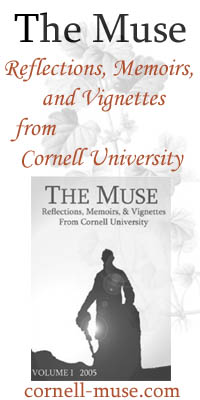Professor Richard Klein '62 has kindly offered to share the full context of his quote used by President Skorton on Friday. Klein had written a letter to Skorton explaining the impetus and ideals behind the founding of Cornell. And in it, Klein defends the centrality of the humanities to the Cornell experience. The letter offers our readers not only a wonderful lesson in the history of Cornell, but also a passionate plea in defense of the soul of our University. I don't want to read between the lines too much, but apparently there was a proposal and/or discussion to more strongly differentiate the educational offerings/experience of the applied colleges from the humanities offered in the College of Arts and Sciences. MPN The most disquieting moment at the faculty meeting last week came when Walter Cohen hurriedly moved past Peter Hohendahl’s reminder of the 19th century origins of Cornell, by in turn reminding him, here in the 21st century, that we are no longer there. By implication, he was suggesting that the future of the university needs to be re-imagined from the perspective of the present, not the past. There are those, however, like the philosopher Simone Weill, who believe that the best models for the future are found in things that have already proven to work. What we re-imagine from the perspective of the present has all the faults and forms of blindness with which we are already afflicted. The past allows us to see things more clearly, clarified by the passage of time, better to discern what stands the test of time and what falls away. At no point in the discussion at the faculty meeting or in the Dean’s report did the question of our Founders enter into the discussion. And yet at the end of the faculty meeting, we were obliged to acknowledge, if only to post-pone, the whole question of Cornell’s specificity. What has made Cornell what it is? We heard much in that faculty meeting about how Cornell compares, very little about what it means. That could not be said of White’s Address which makes clear in bold italics what he takes to be the “Foundational Ideas” of Cornell, of which he says: The close union of liberal and practical education.In his Inaugural Address, in 1868, Andrew Dickson White quotes the letter he had just received from Professor Goldwin Smith, then at Oxford, who advised him: “to remain uninfluenced, either in the way of imitation or antagonism, by other educational institutions or ideas.” (Bishop 89. )
On these is the structure based. . . . Foremost of these stands that cornerstone embedded in the original Charter from Congress:
We may say that any decision or policy that goes in the direction of disconnecting or disassociating liberal arts in the College of Arts and Sciences from the disciplines of other practical colleges violates the founding principle of the University. In the words of Jacob Gould Schurman, the third President, the fundamental principle that guides Cornell, is “to combine the idealism of Ancient Athens with the industrialism of modern America. ) (Ibid.) . It is their “close union” that makes Cornell a place of unusual creativity and entrepreneurship. Idealism comes from Plato’s eidos and Plato has always belonged as vitally to Cornell as Morse’s telegraph.
Andrew White, in his Inaugural Address, continues:
In entire harmony with the spirit and letter of this original Charter was the next foundational idea.
It was put forth by the Founder of the University himself, and in language the simplest and plainest” [In fact, it was White himself who polished those lines and attributed them to Cornell] It gave a complete theory of university education. Said Ezra Cornell::
I would found an institution where any person can find instruction in any study.” (The Inauguration p.11)
And White immediately adds, speaking of Ezra:
Devoted to practical pursuits, he recognized the fact that there has to be a union of the scientific and the aesthetic with the practical to produce results worthy of such an enterprise. (The Inauguration 12)
By science, White means physical science, at a time before social science was invented. The “aesthetic” probably comprises all the liberal arts, including the art of philosophy, which may not have been Ezra’s forte. They are to be unified, he says, with the practical. That is the horizon toward which Cornell must advance in order to produce worthy results. Productivity, as it is defined by Andrew Dickson White, is determined by the worth of what is produced not by its quantity.
By “any study” Cornell and White clearly intended, in the first place, to be countering the division that had always existed, until Cornell, between liberal arts colleges and practical colleges devoted to the mechanics of work. And the dream of “any study” has always seemed a little utopian. But as an idea it remains, as White says, “a whole theory of university education.” Thus, when any decision diminishes the capacity of students to find instruction in any study, it probably violates the founding impulse of the university. When millions are spent on a single laboratory in physics, there is no reason, in light of our founders, to eliminate Turkish as a language we teach.
This sentence of Ezra Cornell is “a whole theory of university education”—a theory that it is the destiny and the privilege of Cornell to embody. Morris Bishop writes in his History of Cornell (1962):
“Ezra Cornell and Andrew Dixon White dealt with great ideas. Ezra Cornell’s purpose to found an institution where any person could find instruction in any study was a conception of extraordinary scope and daring.”
Writing in 1962, Morris Bishop foresaw the moment when research rather than teaching—finding “instruction”-- would become the primary business of the University, something we now seem prepared to take for granted. He wondered, given the “tendency of research to isolate itself in institutions and laboratories,” whether “The Cornell Aeronautical Laboratory may adumbrate the shape of things to come.” (p.614) Against that sort of corruption of the Cornell idea, Bishop quotes Cornell’s fifth President, Edmund Ezra Day, in whose eponymous Hall our President sits, who proclaimed the purpose of Cornell to be “to help the American people see more clearly and live more fully the ideals of American democracy.” (Ibid.) How thrilling that would be if Cornell were to declare its purpose to be one of pursuing and clarifying ideals, especially those of American democracy, at a time when they are everywhere under attack by ignorance and malevolence. Bishop, speaking of Day’s proposal adds: “This humane purpose, naturally strongest in the Arts College, pervades also the other colleges. Conversely, the dedication of the state supported colleges to public service reacts upon the students and faculties of the other schools.”
The specific combination of idealism and practicality at Cornell cannot be separated from the effect of its setting, in a landscape of romantic sublimity. M.H. Abrams in his introduction to Naturalism, Supernaturalism compares the views from the hills of Ithaca to the Lake Country of Wordsworth where thoughts turn more easily to broader perspectives and bolder visions of the greater good. As Morris Bishop writes: “A hundred thousand Cornellians keep close in memory their gorge-gashed campus looking afar over lake and valley.” (Bishop 615) In this place, isolated from the City, but alive with New York rhythms, an ivory tower stuck on a wild hill, half a workshop, half a library, the University produces a distinct type of Cornellian. On the one hand, our students are led with great alacrity to raise issues of social conscience, often well before those of other universities. At the same time, their social awareness is informed by an intellectual climate in which an intensely abstract and theoretical form of speculation focuses often compulsively on questions of language. The same pattern repeats itself in many forms.
When I arrived as a Freshman at Cornell in the Fall of 1958, the events of May still hung in the air. The student body en masse had marched to the home of Deane Mallott, not the Dean but the President of the school, to protest the oppressive rules the university was trying to impose on the cohabitation of men and women in Collegetown. Those demonstrations, brilliantly and eloquently led, were the opening shots in the student movement around the country. They coincided with the moment when Thomas Pynchon bumped into Richard Farina on the Arts Quad. Pynchon writes (in the Introduction to I’ve Been Down So Long It Feels Like Up to Me (1983)):
One day I was crossing the Arts quad and spotted Farina, reclining on the green grass with an open book. We nodded, said hello. “Listen,” Farina said, “I’m having a party Saturday night at my place on College avenue, if you want to fall by.” (p. vi.)
It is no accident that two giant contemporary writers met, as undergraduates, in front of Goldwin Smith Hall. Inside at that moment, Arthur Mizener was reinventing F. Scott Fitzgerald and M. H. Abrams was transforming the history of Romanticism. Norman Malcom had just finished the first biography of Wittgenstein and John Rawls was meditating on the meaning of democracy. James Hutton was rediscovering the Greek Anthology and Frederich Salmson taught Greek. A few feet away Morris Bishop and Vladimir Nabokov were probably in their offices.
There is a Cornell sponsored website, Cornell Writers, that assembles an enormous array, more than two hundred influential figures in American poetry and prose. It reminds us that “for more than a century, some of the most distinguished writers in American letters (novelists, short-story writers, poets, memoirists, and other creative writers) have studied or taught at Cornell University in Ithaca, New York.”
There has been over decades what you could call a Cornell Romanesque, not a style but a mystique that imbues a romantic place of fictions where thousands of adolescents grow into adulthood in this isolated but weirdly cosmopolitan place. There has been around Cornell an aura of magic that has made it a place where for generations writers have found inspiration. And at the center of it is not a technology school but a vibrant College of Arts and Sciences, where bold thoughts and daring enterprise can be dreamed without distraction, where eccentricity and passion, liveliness and risk taking, even wild abandon of thought and language, are entertained and encouraged. I think of Morris Bishop sleeping in the library so he could finish the History of Cornell. Or of Nabokov riding school busses taking notes for Lolita. Or Richard Farina plunging his motorcycle down Buffalo street, screaming Blake and scaring the life out of everyone. Alison Lurie pretending to sleep through faculty meetings then running home to skewer her colleagues precisely. Or Archie Aamons talking frankly with women in the Temple of Zeus in conversations that became audible in his great poetic work. Harold Bloom standing up in MH Abrams lecture to correct in Hebrew his citation from the English Bible. Jacques Derrida, barely known in this country, speaking for three hours in front of an overflowing Cornell public.
Cornell has been a place where the humanities have been at the center of life, where it was possible to think the most critical and passionate thoughts in an atmosphere of fierce mutual attention. Any decisions that reduce its role and threaten its centrality will forever alter the soul of Cornell and destroy what it has so scrupulously nurtured in the spirit of its Founder’s dream.


